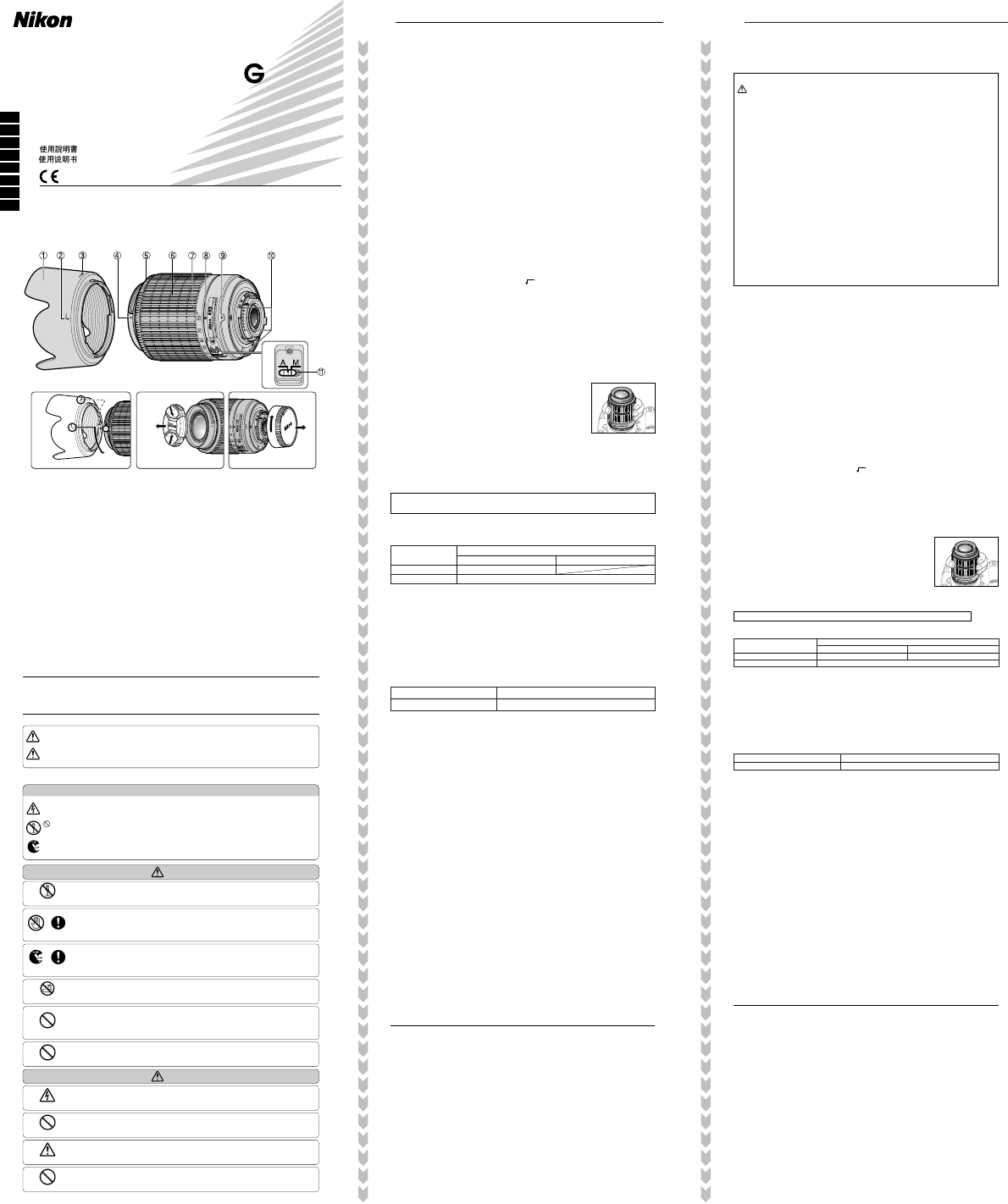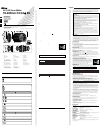
English
Thank you for purchasing the AF-S DX Zoom-Nikkor 55-200mm f/4-5.6G ED. DX Nikkor
lenses are specially designed for use with Nikon digital SLR (Nikon DX format) cameras,
including the D2-Series, D1-Series, D100, D70S, D70 and D50. Before using this lens,
please read these instructions and the Notes on Safety Operations.
Notes on Safety Operations
CAUTION
Do not disassemble
Touching the internal parts of the camera or lens could result in injury. Repairs should be
performed only by qualified technicians. Should the camera or lens break open as the result
of a fall or other accident, take the product to a Nikon-authorized service representative for
inspection after unplugging the product and/or removing the battery.
Turn off immediately in the event of malfunction
Should you notice smoke or an unusual smell coming from the camera or lens, remove the
battery immediately, taking care to avoid burns. Continued operation could result in injury.
After removing or disconnecting the power source, take the equipment to a Nikon-
authorized service representative for inspection.
Do not use the camera or lens in the presence of flammable gas
If the electronic equipment is operated in the presence of flammable gas, it could result in
an explosion or a fire.
Do not look at the sun through the lens or viewfinder
Viewing the sun or other strong light sources through the lens or viewfinder could cause
permanent visual impairment.
Keep out of reach of children
Particular care should be taken to prevent infants from putting the batteries or other small parts
into their mouths.
Observe the following precautions when handling the camera and lens
• Keep the camera or lens unit dry. Failure to do so could result in a fire or electric shock.
• Do not handle or touch the unit with wet hands. Failure to do so could result in electric
shock.
• When the lens will not be used for a long time, attach both front and rear lens caps and
store the lens away from direct sunlight. Failure to do so could result in a fire, as the lens
might focus sunlight onto an object.
Major features
• This lens employs a Silent Wave Motor to drive the focusing mechanism, making
autofocusing smooth, silent and almost instantaneous. The A-M mode switch is provided to
easily select autofocus (A) or manual focus (M) operations.
• More accurate exposure control is possible when this is mounted on a Nikon camera having
3D Matrix Metering capability, because subject distance information is transferred from the
lens to the camera body.
• The use of two ED (extra-low dispersion) lens elements ensures sharp pictures virtually free of
color fringing. Also, by utilizing a 9-blade diaphragm that produces a nearly circular aperture,
out-of-focus images in front of or behind the subject are rendered as pleasing blurs.
Mounting the lens
1Turn the camera off.
2Remove the rear lens cap (Fig. D).
3Keeping the mounting index on the lens aligned with the mounting mark on the camera
body, rotate the lens counterclockwise until it clicks into place. Make sure that the mounting
index is at the uppermost side.
4Remove the front lens cap. (Fig. C)
Detaching the lens
Be sure to turn the camera off when removing the lens. Press and hold the lens-release button
while turning the lens clockwise to detach. For more details, refer to your camera instruction
manual.
Using bayonet hood HB-34* (Fig. B) *Only available in black.
Attaching the hood
• Align the lens hood attachment index 2( ) on the hood with the lens hood mounting
index
4on the lens, and turn the hood 1counterclockwise as viewed from the camera
side until it stops with a click. If the lens hood is not correctly attached, vignetting can occur.
• To facilitate attachment or removal of the lens hood, hold it by its base rather than the outer edge.
• To store the lens hood, attach it in the reverse position.
Detaching the hood
While holding it by the base rather than its outer edge, detach the hood 1by turning it
clockwise as viewed from the camera side.
Focusing, zooming, and depth of field
Before focusing, turn the zoom ring 6to change the focal length until
the desired composition is framed in the viewfinder. Turn the zoom ring
clockwise as viewed from the camera side to take telephoto pictures
and counterclockwise to take wide-angle pictures. If your camera has
a depth of field preview (stop-down) button or lever, depth of field can
be observed while looking through the camera viewfinder. See the
instruction manual of your camera body for more details.
Focusing (Fig. A)
Autofocus mode: Set the camera’s focus mode to AF (C/S) and set the lens’ A-M mode
switch
"to A. Autofocus is provided while lightly pressing the shutter release button.
Be careful not to touch the focus ring when it is turning during autofocus operation.
Manual focus mode: Set the camera’s focus mode to AF (C/S) or M and set the lens’ A-M
mode switch
"to M. Turn the focus ring 5manually to focus.
Setting the aperture
Set the aperture on the camera body.
Variable maximum apertures
Zooming the lens from 55mm to 200mm decreases the maximum aperture by one f/stop.
However, there is no need to adjust the aperture for correct exposures because the camera
automatically compensates for this variation.
Taking flash pictures using cameras with a built-in flash
Vignetting is the darkening of the corners around the image that occurs when the light emitted
from the flash is obstructed by the lens hood, or lens barrel depending on the focal length.
Lens care
• Be careful not to soil or damage the CPU contacts.
• Clean the lens surfaces with a blower brush. To remove dirt and smudges, use a soft, clean
cotton cloth or lens tissue moistened with ethanol (alcohol) or lens cleaner. Wipe in a circular
motion from center to outer edge, taking care not to leave traces or touch other parts of the lens.
• Never use thinner or benzene to clean the lens, as this might damage it, result in a fire or
cause health problems.
• To protect the front lens element, an NC filter is available. A lens hood also helps protect the
front of the lens.
• When storing the lens in its flexible lens pouch, attach both the front and rear lens caps.
• When the lens will not be used for a long time, store it in a cool, dry place to prevent mold.
Also store the lens away from direct sunlight or chemicals such as camphor or naphthalene.
• Do not get water on the lens or drop it in water as this will cause it to rust and malfunction.
• Reinforced plastic is used for certain parts of the lens. To avoid damage, never leave the
lens in an excessively hot place.
Standard accessories
• 52mm snap-on front lens cap LC-52 • Rear lens cap LF-1
• Bayonet hood HB-34* • Flexible lens pouch CL-0815 *Only available in black.
Optional accessories
• 52mm screw-in filters
• Close-up attachment lenses (No. 0, 1, 2, 3T, 4T). Focus manually when these lenses are
attached. The No. 3T and 4T are for medium 85mm to 200mm telephoto lenses.
Incompatible accessories
• Teleconverters (all models)
• Auto Ring BR-4 and all models of Auto Extension Ring PK, K Ring and Bellows focusing
attachment.
Other accessories might not be suitable for use with this lens. For details, check your
accessories instruction manual.
Specifications
Type of lens: G-type AF-S DX Zoom-Nikkor lens with built-in CPU and Nikon
bayonet mount (Specially designed for use with Nikon digital
SLR – Nikon DX format – cameras)
Focal length: 55mm–200mm
Maximum aperture: f/4–5.6
Lens construction: 13 elements in 9 groups (2 ED lens elements)
Picture angle: 28°50’–8°
Focal length scale: 55, 70, 85, 105, 135, 200mm
Distance information: Output to camera body
Zoom control: Manually via separate zoom ring
Focusing:
Autofocus using a Silent Wave Motor; manually via separate focus ring
Closest focus distance: 0.95m (3.1 ft.) at all zoom settings
Diaphragm: Fully automatic
Aperture range: f/4 to f/22 (at 55mm), f/5.6 to f/32 (at 200mm)
Exposure measurement:Via full-aperture method
Attachment size: 52mm (P = 0.75mm)
Dimensions: Approx. 68mm dia. x 79mm extension from the camera’s lens-mount
flange
Weight: Approx. 255g (9 oz)
Specifications and designs are subject to change without any notice or obligation on the part
of the manufacturer.
1
2
3
4
4 2
1
1
6
"
" 5
B
DC
A
1
Lens hood
Gegenlichtblende
Pare-soleil
2
Lens hood attachment index
Gegenlichtblende-Anbringindex
Index de fixation du pare-soleil
3
Lens hood setting index
Gegenlichtblende-Einstellindex
Index de réglage du pare-soleil
4
Lens hood mounting index
Gegenlichtblende-Montageindex
Index de montage du pare-soleil
5
Focus ring
Entfernungseinstellring
Bague de mise au point
6
Zoom ring
Zoomring
Bague de zoom
7
Focal length scale
Brennweitenskala
Echelle de focale
8
Focal length index
Brennweiten-Index
Index des distances focales
9
Mounting index
Objektivindex
Index de montage
!
CPU contacts
CPU-Kontakte
Contacts CPU
"
A-M mode switch
Fokus-Modusschalter (A-M)
Commutateur de mode A-M
NIKON CORPORATION
FUJI BLDG., 2-3, MARUNOUCHI 3-CHOME, CHIYODA-KU,
TOKYO 100-8331, JAPAN
Printed in Japan TT5C03000101 (80) 7MAA24D3--
J
p
En
De
Fr
Es
It
Ck
Ch
Instruction Manual
Bedienungsanleitung
Manuel d’utilisation
Manual de instrucciones
Manuale di istruzioni
AF-S DX Zoom-Nikkor
55-200mm f/4-5.6 ED
No reproduction in any form of this manual, in whole or in part (except for brief quotation in critical articles
or reviews), may be made without written authorization from NIKON CORPORATION.
Lens’ A-M mode switch
A
M
Camera’s focus mode
Autofocus (AF) Manual focus (M)
Autofocus
—
Manual focus (Focus assist is available)
For more details on camera’s focus mode, refer to your camera instruction manual.
Digital SLR cameras
D100, D70S, D70, D50
Usable focal length / Shooting distance
No vignetting occurs at any focal length



